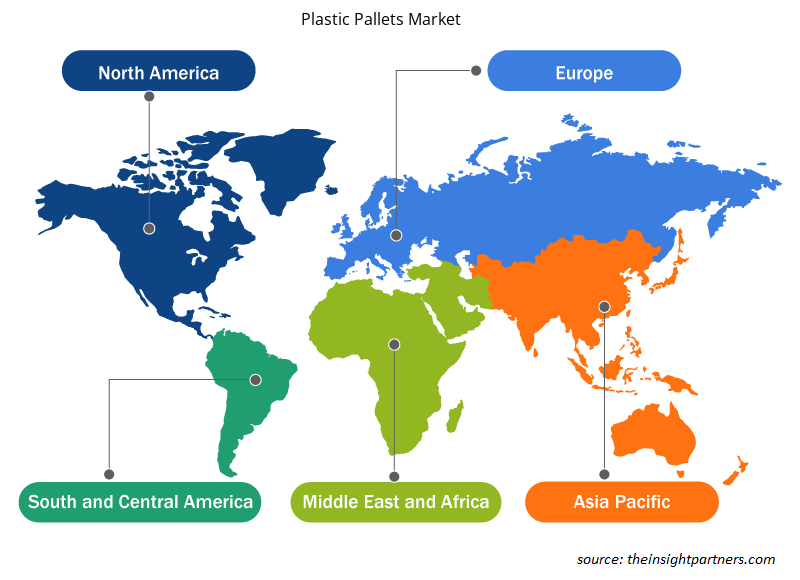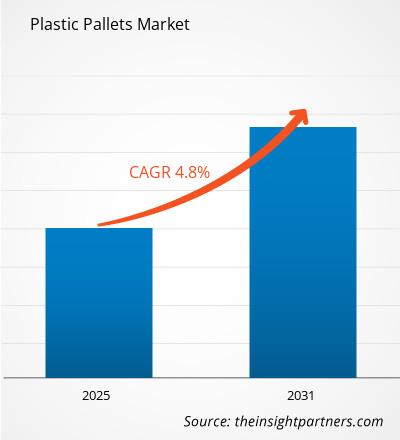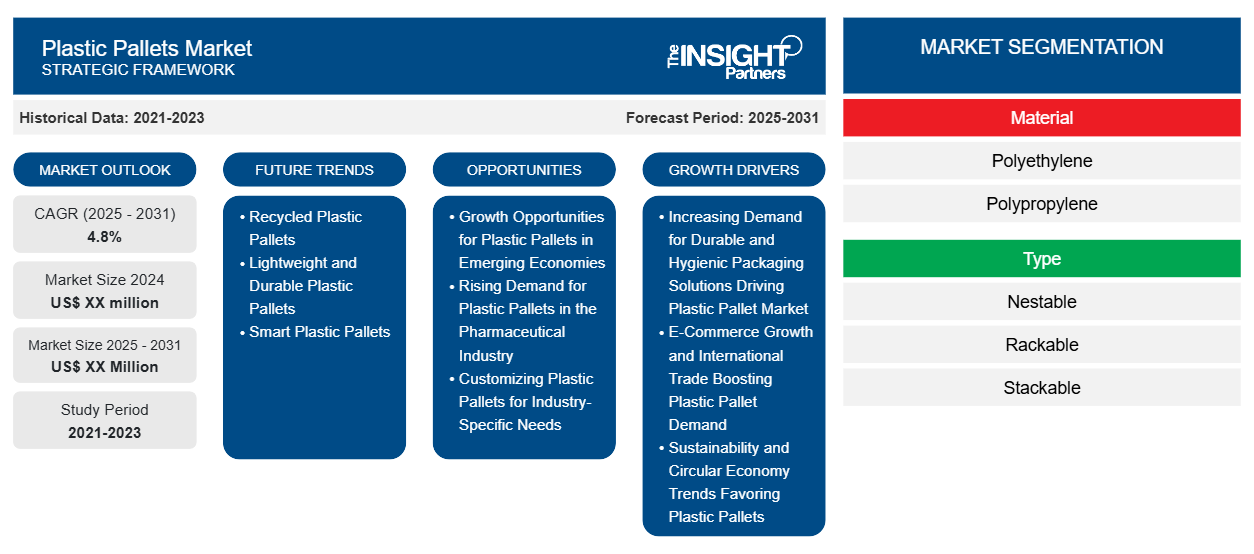预计塑料托盘市场在 2023 年至 2031 年期间的复合年增长率为 4.8%,市场规模将从 2023 年的 XX 百万美元扩大到 2031 年的 XX 百万美元。
报告按材料(聚乙烯、聚丙烯等)细分。报告进一步按类型细分(可嵌套、可架装、可堆叠等)。报告按最终用途细分(食品和饮料、化学品、石油和润滑剂、制药、汽车、建筑、零售等)。报告范围涵盖五个地区:北美、欧洲、亚太、中东和非洲、南美和中美洲以及每个地区下的主要国家。全球分析进一步细分为区域和主要国家。报告以美元为单位提供上述分析和细分的价值。
报告目的
The Insight Partners 的《塑料托盘市场》报告旨在描述当前形势和未来增长、主要驱动因素、挑战和机遇。这将为各种业务利益相关者提供见解,例如:
- 技术提供商/制造商:了解不断变化的市场动态并了解潜在的增长机会,从而能够做出明智的战略决策。
- 投资者:对市场增长率、市场财务预测以及整个价值链中存在的机会进行全面的趋势分析。
- 监管机构:监管市场政策和警察活动,旨在最大限度地减少滥用行为,维护投资者的信任和信心,维护市场的完整性和稳定性。
塑料托盘市场细分
材料
- 聚乙烯
- 聚丙烯
类型
- 可嵌套
- 可架置
- 可堆叠
最终用途
- 食品和饮料
- 化学品
- 石油和润滑油
- 药品
- 汽车
- 建造
- 零售
地理
- 北美
- 欧洲
- 亚太
- 南美洲和中美洲
- 中东和非洲
地理
- 北美
- 欧洲
- 亚太
- 南美洲和中美洲
- 中东和非洲
定制此报告以满足您的需求
您可以免费定制任何报告,包括本报告的部分内容、国家级分析、Excel 数据包,以及为初创企业和大学提供优惠和折扣
- 获取此报告的关键市场趋势。这个免费样品将包括数据分析,从市场趋势到估计和预测。
塑料托盘市场的增长动力
- 对耐用和卫生包装解决方案的需求不断增长,推动塑料托盘市场:全球食品和饮料、制药、化学品和物流行业对坚固、轻便和高效包装解决方案的需求不断增长,这是塑料托盘市场的主要驱动力。塑料托盘比木材更具优势,因为它们耐用、耐潮、耐化学品、防虫。它们更容易清洁和消毒。这些应用本质上更卫生,类似于食品加工和制药行业使用的包装。供应链的进一步复杂性将与对安全、可重复使用和高效包装的需求直接相关。
- 电子商务和国际贸易增长推动塑料托盘需求:电子商务和国际贸易呈爆炸式增长,对塑料托盘的需求巨大。随着网上购物、物流和仓储服务的蓬勃发展,各公司都在寻找能够简化运输和仓储的包装材料。塑料是一种不错的选择,因为它们易于处理:它们重量轻、可堆叠且经久耐用;它们使处理过程顺畅,降低运输成本,并有助于优化仓库管理。此外,由于有这样一个直接面向消费者和国际贸易扩张的新方向,包装也必须足够坚固,以便能够承受长途运输。塑料、包装和包裹等行业对塑料托盘的需求加速增长;它们之所以受欢迎,是因为它们提供可持续、经济高效和高性能的包装。
- 可持续性和循环经济趋势有利于塑料托盘:塑料托盘的使用越来越取决于环境法规和可持续性需求。塑料托盘可回收、可重复使用,并可由再生塑料生产;然而,使用木质托盘会导致树木砍伐。塑料托盘市场受益于对这些环保替代品的需求增加,因为企业和政府不断推进更可持续的做法,减少对木质材料的依赖。许多行业都在采用循环经济模式,而塑料托盘凭借较长的生命周期和可回收性,完全可以满足这些要求。
塑料托盘市场未来趋势
- 再生塑料托盘:再生塑料的使用是当今全球塑料托盘市场的强大推动力。趋势是采购消费后再生 (PCR) 塑料,例如再生 PET (rPET),并制造满足环境和功能要求的托盘。推动这一趋势的力量一方面是消费者偏好,另一方面是监管要求,从而减少浪费。再生塑料的使用减少了塑料托盘对环境的影响,同时为制造商节省了材料。这正成为公司寻求如何吸引现在更加注重环保的消费者和企业的主要差异化因素。
- 轻质耐用的塑料托盘:提高运输效率:对轻质但非常耐用的塑料托盘的需求。轻质托盘足够坚固,可以支撑沉重的运输负载,同时降低运输成本,这在当今的物流和电子商务等行业中很常见。使用轻质塑料托盘可有效帮助降低运输中的燃料消耗并建立更高效的供应链。制造商已经创新了新材料,例如高强度聚合物和先进设计,将轻质和强度的最佳属性与经济和性能价值相结合。
- 智能塑料托盘:RFID 标签和物联网传感器等技术与塑料托盘的互连。这些智能托盘有助于跟踪整个供应链中的货物,这意味着可以获得有关库存、位置和状况的实时数据。所有这些都增强了与仓库流程集成的可见性,并最大限度地减少了损失或盗窃。随着数据驱动型行业(尤其是零售、制药和食品饮料)在供应链中使用自动化的增长,智能塑料托盘的使用也在增加。
塑料托盘市场机会
- 新兴经济体塑料托盘的增长机会:新兴经济体,主要是亚太、拉丁美洲和非洲,工业化和城镇化显著增长,为塑料托盘市场提供了潜在的增长机会。随着制造业、电子商务和零售业的快速增长,对高效耐用的包装解决方案的需求日益增加。对更好的供应链基础设施和更安全的货物运输的需求是这些市场增加塑料托盘使用量的主要驱动因素之一。制造商可以通过提高生产能力、建立本地合作伙伴关系以及使用具有成本效益、可持续的木质托盘替代品来利用这些机会。
- 制药行业对塑料托盘的需求不断增长:塑料托盘市场将迎来来自制药行业的重大销售机会,未来几年供应链和产品完整性将变得更加严格。医药产品,尤其是需要冷藏和小心处理的药品,需要满足卫生、坚固和安全要求的包装。塑料托盘可以做到这一点,因为它们可以隔绝水分、化学物质和污染物。与木质托盘相比,塑料托盘更容易消毒。随着全球医药市场的增长,特别是在新兴市场,塑料托盘在医药分销和储存中的应用正在增加。
- 根据行业特定需求定制塑料托盘:定制塑料托盘的需求不断增长,这些托盘旨在满足行业或应用的特定要求。现在,制造商生产各种尺寸、颜色和配置的托盘,以满足汽车制造商、零售商、食品和饮料以及其他行业按规模划分的不同业务需求。它可能来自重型边缘、对超大负载的更多支持或更高的堆叠能力。凭借良好的增长前景,存在增长空间,带来针对特定行业需求的定制塑料托盘设计,而如今,越来越多的企业寻求空间、更好的利用率和通过降低成本的解决方案提高效率。
塑料托盘市场区域洞察
Insight Partners 的分析师已详细解释了预测期内影响塑料托盘市场的区域趋势和因素。本节还讨论了北美、欧洲、亚太地区、中东和非洲以及南美和中美洲的塑料托盘市场细分和地理位置。

- 获取塑料托盘市场的区域特定数据
塑料托盘市场报告范围
| 报告属性 | 细节 |
|---|---|
| 2023 年的市场规模 | XX 百万美元 |
| 2031 年市场规模 | XX 百万美元 |
| 全球复合年增长率(2023 - 2031) | 4.8% |
| 史料 | 2021-2022 |
| 预测期 | 2024-2031 |
| 涵盖的领域 | 按材质
|
| 覆盖地区和国家 | 北美
|
| 市场领导者和主要公司简介 |
|
塑料托盘市场参与者密度:了解其对业务动态的影响
塑料托盘市场正在快速增长,这得益于终端用户需求的不断增长,而这些需求又源于消费者偏好的不断变化、技术进步以及对产品优势的认识不断提高等因素。随着需求的增加,企业正在扩大其产品范围,进行创新以满足消费者的需求,并利用新兴趋势,从而进一步推动市场增长。
市场参与者密度是指在特定市场或行业内运营的企业或公司的分布情况。它表明相对于给定市场空间的规模或总市场价值,有多少竞争对手(市场参与者)存在于该市场空间中。
在塑料托盘市场运营的主要公司有:
- 欧米帕克公司
- 路凯
- 奥比斯公司
- 贝库普拉斯特有限公司
- Meridian 集团
免责声明:上面列出的公司没有按照任何特定顺序排列。

- 了解塑料托盘市场主要参与者概况
主要卖点
- 全面覆盖:报告全面涵盖了塑料托盘市场的产品、服务、类型和最终用户的分析,提供了整体概况。
- 专家分析:报告基于对行业专家和分析师的深入了解而编写。
- 最新信息:该报告涵盖了最新信息和数据趋势,确保了其与业务的相关性。
- 定制选项:此报告可以定制以满足特定客户要求并恰当地适应业务策略。
因此,塑料托盘市场研究报告有助于引领解读和了解行业情景和增长前景。尽管可能存在一些合理的担忧,但本报告的总体优势往往大于劣势。
- 历史分析(2 年)、基准年、预测(7 年)及复合年增长率
- PEST和SWOT分析
- 市场规模、价值/数量 - 全球、区域、国家
- 行业和竞争格局
- Excel 数据集
近期报告
相关报告
客户评价
购买理由
- 明智的决策
- 了解市场动态
- 竞争分析
- 客户洞察
- 市场预测
- 风险规避
- 战略规划
- 投资论证
- 识别新兴市场
- 优化营销策略
- 提升运营效率
- 顺应监管趋势























 获取免费样品 - 塑料托盘市场
获取免费样品 - 塑料托盘市场